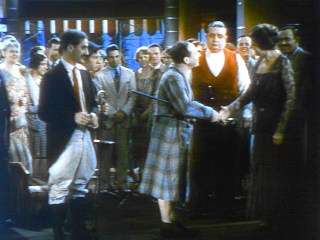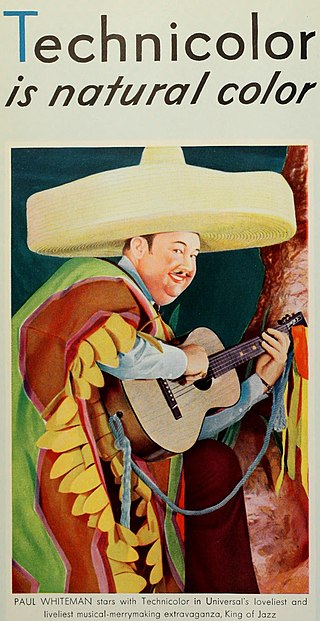
Film stock is an analog medium that is used for recording motion pictures or animation. It is recorded on by a movie camera, developed, edited, and projected onto a screen using a movie projector. It is a strip or sheet of transparent plastic film base coated on one side with a gelatin emulsion containing microscopically small light-sensitive silver halide crystals. The sizes and other characteristics of the crystals determine the sensitivity, contrast and resolution of the film. The emulsion will gradually darken if left exposed to light, but the process is too slow and incomplete to be of any practical use. Instead, a very short exposure to the image formed by a camera lens is used to produce only a very slight chemical change, proportional to the amount of light absorbed by each crystal. This creates an invisible latent image in the emulsion, which can be chemically developed into a visible photograph. In addition to visible light, all films are sensitive to X-rays and high-energy particles. Most are at least slightly sensitive to invisible ultraviolet (UV) light. Some special-purpose films are sensitive into the infrared (IR) region of the spectrum.

35 mm film is a film gauge used in filmmaking, and the film standard. In motion pictures that record on film, 35 mm is the most commonly used gauge. The name of the gauge is not a direct measurement, and refers to the nominal width of the 35 mm format photographic film, which consists of strips 1.377 ± 0.001 inches (34.976 ± 0.025 mm) wide. The standard image exposure length on 35 mm for movies is four perforations per frame along both edges, which results in 16 frames per foot of film.
The following list comprises significant milestones in the development of photography technology.

The Academy Award for Best Costume Design is one of the Academy Awards presented annually by the Academy of Motion Picture Arts and Sciences (AMPAS) for achievement in film costume design.
A feature film or feature-length film, is a narrative film with a running time long enough to be considered the principal or sole presentation in a commercial entertainment program. The term feature film originally referred to the main, full-length film in a cinema program that included a short film and often a newsreel. Matinee programs, especially in the US and Canada, in general, also included cartoons, at least one weekly serial and, typically, a second feature-length film on weekends.
Digital intermediate (DI) is a motion picture finishing process which classically involves digitizing a motion picture and manipulating the color and other image characteristics.

Cinecolor was an early subtractive color-model two-color motion picture process that was based upon the Prizma system of the 1910s and 1920s and the Multicolor system of the late 1920s and the 1930s. It was developed by William T. Crispinel and Alan M. Gundelfinger, and its various formats were in use from 1932 to 1955.

Ektachrome is a brand name owned by Kodak for a range of transparency, still and motion picture films previously available in many formats, including 35 mm and sheet sizes to 11 × 14 inch size. Ektachrome has a distinctive look that became familiar to many readers of National Geographic, which used it extensively for color photographs for decades in settings where Kodachrome was too slow. In terms of reciprocity characteristics, Ektachrome is stable at shutter speeds between ten seconds and 1/10,000 of a second.
Consolidated Film Industries was a film laboratory and film processing company and was one of the leading film laboratories in the Los Angeles area for many decades. CFI processed negatives and made prints for motion pictures and television. The company and its employees received many Academy Awards for scientific or technical achievements.
Eastman Color Negative (ECN) is a photographic processing system created by Kodak in the 1950s for the development of monopack color negative motion picture film stock. It is part of the Eastmancolor family of products sold by Eastman Kodak.

Multicolor is a subtractive two-color motion picture process. Multicolor, introduced to the motion picture industry in 1929, was based on the earlier Prizma Color process, and was the forerunner of Cinecolor.

Color motion picture film refers both to unexposed color photographic film in a format suitable for use in a motion picture camera, and to finished motion picture film, ready for use in a projector, which bears images in color.
Eastmancolor is a trade name used by Eastman Kodak for a number of related film and processing technologies associated with color motion picture production and referring to George Eastman, founder of Kodak.
Trucolor was a color motion picture process used and owned by the Consolidated Film Industries division of Republic Pictures. It was introduced as a replacement for Consolidated's own Magnacolor process.

The Prizma Color system was a color motion picture process, invented in 1913 by William Van Doren Kelley and Charles Raleigh. Initially, it was a two-color additive color system, similar to its predecessor, Kinemacolor. However, Kelley eventually transformed Prizma into a bi-pack color system that itself became the predecessor for future color processes such as Multicolor and Cinecolor.
In motion pictures, Kodak's Kodacolor brand was originally associated with an early lenticular color motion picture process, first introduced in 1928 for 16mm film. The process was based on the Keller-Dorian system of color photography.
In bipack color photography for motion pictures, two strips of black-and-white 35 mm film, running through the camera emulsion to emulsion, are used to record two regions of the color spectrum, for the purpose of ultimately printing the images, in complementary colors, superimposed on one strip of film. The result is a multicolored projection print that reproduces a useful but limited range of color by the subtractive color method. Bipack processes became commercially practical in the early 1910s when Kodak introduced duplitized film print stock, which facilitated making two-color prints.

Technicolor is a series of color motion picture processes, the first version dating back to 1916, and followed by improved versions over several decades.
Eastman Color Positive (ECP) is a photographic processing system created by Kodak in the 1950s for the development of monopack color positive print for direct projection motion picture film stock. It is part of the Eastmancolor family of products sold by Kodak.








